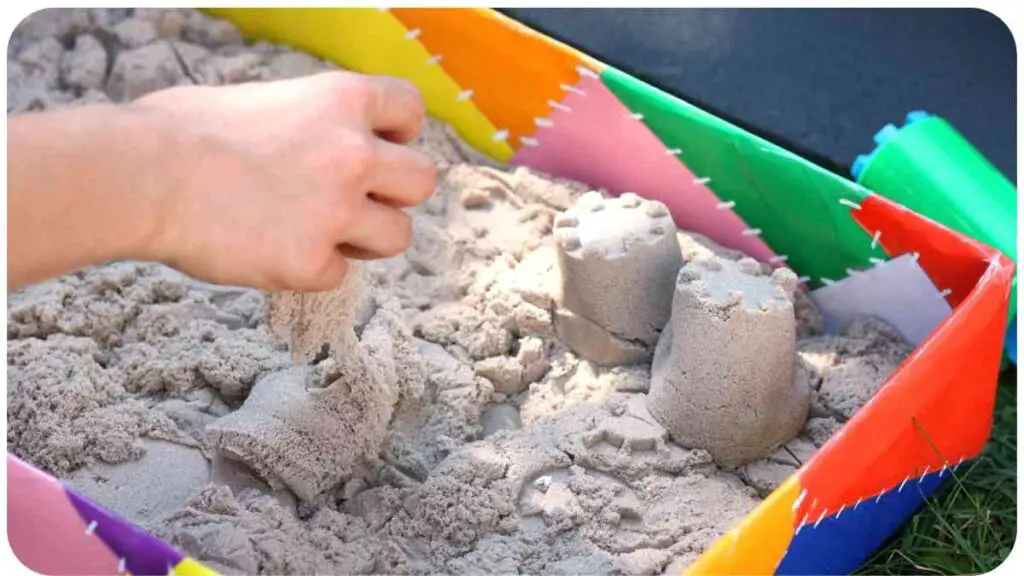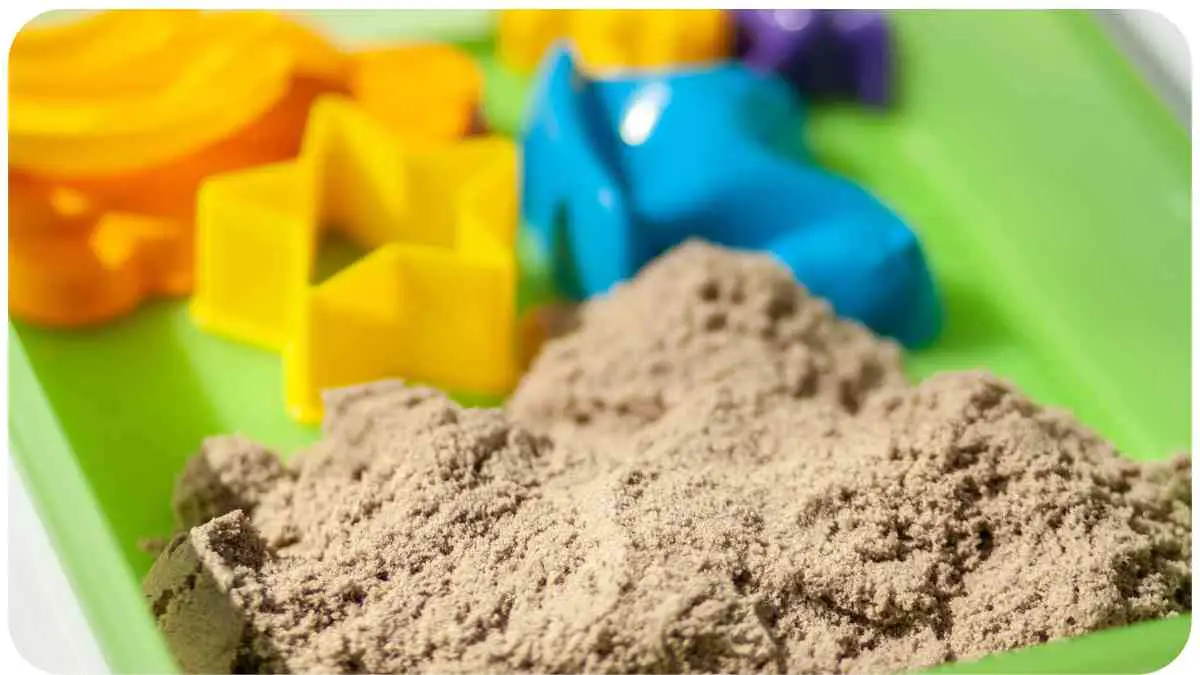When it comes to tactile play experiences for children, sensory sand and kinetic sand have gained immense popularity. Parents and educators are often torn between the two options, wondering which one is better suited for their needs.
In this article, we dive deep into the world of sensory sand and kinetic sand, exploring their characteristics, benefits, and differences. By the end, you’ll have a clear understanding of each type of sand and be able to make an informed decision.
| Takeaways |
|---|
| Sensory sand and kinetic sand offer unique sensory play experiences for children. |
| Sensory sand provides tactile and visual stimulation, enhancing sensory integration skills and creativity. |
| Kinetic sand is non-sticky, easily moldable, and promotes sensory exploration and problem-solving abilities. |
| Sensory sand may leave a residue and requires a thorough cleanup, while kinetic sand is virtually mess-free. |
| Consider the specific needs, preferences, and age of the child when choosing between sensory sand and kinetic sand. |
| Both types of sand have their own advantages, so personal preference and the desired play experience should be taken into account. |
| Ensure safety by checking for allergens, providing adult supervision, and practicing proper hand hygiene. |
| Use sensory and kinetic sands in various play and learning activities to support creativity, fine motor skills, and sensory development. |
| Explore further resources to learn more about the different types of sensory sand and kinetic sand available. |
What is Sensory Sand?
Sensory sand, as the name suggests, is a type of sand that stimulates the senses of touch and sight. It is a versatile and moldable material that provides a sensory-rich experience for children. Sensory sand is designed to offer tactile and visual stimulation while encouraging imaginative play and creativity.
Sensory play is a critical component in a child’s developmental journey. By engaging in activities like these, toddlers learn and grow in unparalleled ways. Our guide on sensory play enhancing learning and development for toddlers offers parents valuable insights into the benefits and methods of incorporating such play.
Benefits of Sensory Sand
Sensory sand offers numerous benefits for children’s development. It enhances sensory integration skills, fine motor skills, hand-eye coordination, and creativity. The tactile experience of manipulating the sand supports sensory processing and can be particularly beneficial for children with sensory processing disorders.
Types of Sensory Sand
There are various types of sensory sand available in the market. Here is a comparison table highlighting some popular options:
What is Kinetic Sand?
Kinetic sand is a unique type of sand that sticks to itself and can be molded easily. It feels like wet beach sand, but it doesn’t dry out or stick to hands or surfaces. Kinetic sand is designed to provide a mess-free and interactive play experience.
Even in the earliest stages of life, sensory experiences pave the way for cognitive, motor, and social growth. Parents seeking to understand the profound impact of sensory activities should explore the importance of sensory play for babies, a resource that underscores the significance of early sensory engagement.
Benefits of Kinetic Sand
Kinetic sand offers several advantages for children’s play and development. It enhances sensory exploration, fine motor skills, creativity, and problem-solving abilities. The non-sticky and pliable nature of kinetic sand makes it enjoyable for children of all ages.
Types of Kinetic Sand

Let’s take a look at some popular brands of kinetic sand available in the market:
Sensory Sand vs. Kinetic Sand: A Comparison
Both sensory sand and kinetic sand provide unique sensory play experiences, but there are some key differences between the two. Here’s a comparison table to help you understand them better:
| Aspect | Sensory Sand | Kinetic Sand |
| Texture | Soft, grainy | Pliable, resembles wet sand |
| Stickiness | Minimal to moderate | Non-sticky, doesn’t adhere to hands or surfaces |
| Moldability | High moldability, holds shapes well | Easily moldable; sand crumbles easily |
| Cleanup | May leave residue, easier to clean from hard surfaces | Virtually mess-free, easy to clean |
| Play Experience | Offers tactile and visual stimulation, encourages creativity | Interactive play experience, promotes sensory exploration and problem-solving skills |
While both types of sand have their merits, I personally find sensory sand to be more advantageous for various reasons.
Tips for Choosing the Right Sand
To help you make an informed decision, here are some tips for choosing the right sand:
- Consider the age and developmental stage of the child. Some sands may be more suitable for younger children, while others offer more complexity for older children.
- Take into account any specific sensory needs or preferences the child may have. Different sands provide different sensory experiences.
- Read reviews and seek recommendations from trusted sources to gain insights into the quality and durability of the sand.
- Check for any allergens or concerns regarding the sand’s ingredients to ensure it is safe for the child to use.
- Consider the play environment and cleanup process. Some sands are more suitable for indoor play due to their ease of cleaning, while others may be better suited for outdoor use.
Remember, the ultimate goal is to provide a fun and engaging sensory experience for the child, while also considering practicality and safety.
Babies are sponges for new experiences, and sensory toys can play a pivotal role in their development. By introducing them to various textures, sounds, and shapes, you enrich their world. Our article discussing introducing sensory toys for your baby’s development offers a deep dive into these tools and their benefits.
Where to Buy Sensory and Kinetic Sands
Sensory sand and kinetic sand can be found in various retail stores, both online and offline. Here are some popular places where you can purchase these sands:
- Toy stores: Visit your local toy store to find a variety of options available.
- Educational supply stores: These stores often carry sensory and educational materials, including sensory sand and kinetic sand.
- Online marketplaces: Websites such as Amazon, Walmart, and specialty toy retailers offer a wide range of choices and convenient online shopping.
- Educational catalogs: Many educational catalogs and websites offer sensory materials for purchase, including these sands.
Be sure to check customer reviews, product descriptions, and available options before making a purchase.
How to Use Sensory and Kinetic Sands
Sensory and kinetic sands can be used in a multitude of ways to promote imaginative play and learning experiences. Here are a few ideas to get you started:
- Free play: Allow children to explore and manipulate the sand freely, encouraging their creativity and imagination.
- Sensory bins: Create sensory bins filled with sand and include various tools and objects for children to discover and play with.
- Fine motor activities: Integrate the use of sand into activities that promote fine motor skills, such as scooping, pouring, or molding shapes.
- Sensory therapy: Utilize sensory sand for therapeutic purposes, providing a calming and engaging experience for children with sensory processing disorders.
The possibilities are endless, and the only limit is your imagination!
The magic behind sensory play isn’t just about tactile experiences. It’s deeply rooted in science, with each activity having its impact on the brain. To gain a comprehensive understanding of this, our article understanding the science behind sensory play delves into the neurological effects and benefits of sensory stimulation.
Safety Considerations
While sensory and kinetic sands are generally safe for play, it’s essential to ensure a safe environment for children. Here are some safety considerations to keep in mind:
- Check for any allergens or specific safety warnings mentioned on the product packaging or manufacturer’s website.
- Adult supervision is recommended, particularly for younger children, to prevent ingestion or misuse of the sand.
- Ensure that children wash their hands before and after playing with the sand to maintain hygienic practices.
- Store the sand properly in sealed containers to prevent contamination or drying out.
By following these safety guidelines, you can create a secure and enjoyable play experience for children.
While sensory sand and kinetic sand remain popular, other materials like water beads present unique sensory experiences. There are numerous aspects to consider, from safety to developmental benefits. Dive into our exploration of the pros and cons of water beads in sensory play to make informed decisions for your child’s playtime.
Conclusion
In the debate between sensory sand and kinetic sand, there is no clear winner as both options offer unique qualities and benefits. Sensory sand provides a tactile and visual experience that promotes creativity and sensory integration skills. On the other hand, kinetic sand offers an interactive and mess-free play experience that enhances sensory exploration and problem-solving abilities.
To make the right choice, consider the specific needs, preferences, and age of the child. Remember to factor in aspects like texture, stickiness, moldability, cleanup, and the overall play experience each sand offers.
Further Reading
Here are some additional resources you can explore to learn more about sensory sand and kinetic sand:
- Educadora Webshop – Sensory Sand: This website provides information about sensory sand, its benefits, and different types available. It also offers tips on how to incorporate sensory sand into play and learning activities.
- Enviromom – Moon Sand vs. Kinetic Sand: This article compares moon sand and kinetic sand, highlighting their similarities and differences. It offers insights into their play characteristics, ingredients, and practical considerations.
- Simply Designing – Best Sensory Sand for Sensory Play: This blog post explores different sensory sand options and provides recommendations for the best ones to use in sensory play. It includes product reviews and tips for maximizing the sensory play experience.
These resources can expand your knowledge and help you make an informed decision when choosing the right sand for your needs.
FAQs
Here are some frequently asked questions about sensory sand and kinetic sand:
Q: Is sensory sand safe for children to play with?
A: Yes, sensory sand is generally safe for children. However, adult supervision is recommended, especially for younger children, to prevent ingestion and misuse.
Q: Can I mix different types of sensory sand together?
A: Mixing different types of sensory sand can be a fun and creative way to explore new textures and colors. However, be sure to check if the sands are compatible and safe to mix based on the manufacturer’s guidelines.
Q: Does kinetic sand dry out over time?
A: Kinetic sand is designed to stay moist and pliable, so it doesn’t dry out like regular sand. However, if left exposed to air for an extended period, it may lose some of its moisture and become less moldable.
Q: How do I clean up sensory sand after playtime?
A: Cleaning up sensory sand can vary depending on the type and play environment. Vacuuming or using a dustpan and brush can help with collecting loose particles. For hard surfaces, wiping with a damp cloth usually does the trick. Always refer to the specific cleaning instructions provided by the sand manufacturer.
Q: Can sensory sand be used for therapy purposes?
A: Yes, sensory sand is often used in sensory therapy to provide a calming and engaging experience for individuals with sensory processing disorders or other sensory-related challenges. It can help improve sensory integration, fine motor skills, and relaxation.
These questions and answers aim to address common concerns and provide useful information about sensory sand and kinetic sand.

Meet Hellen James, the multi-talented writer and nurturing mother who takes young readers on a thrilling journey through her sensory-infused blog. Drawing inspiration from her own experiences as a parent.

